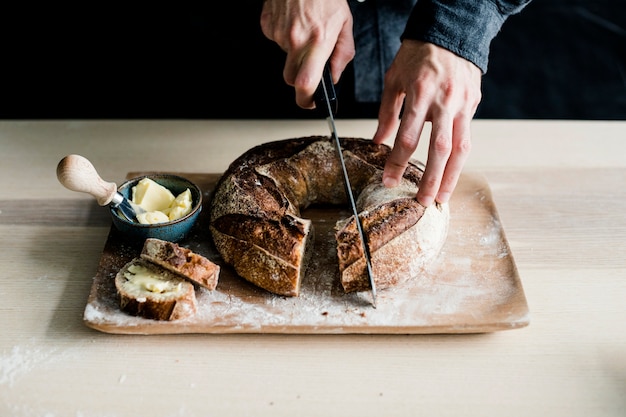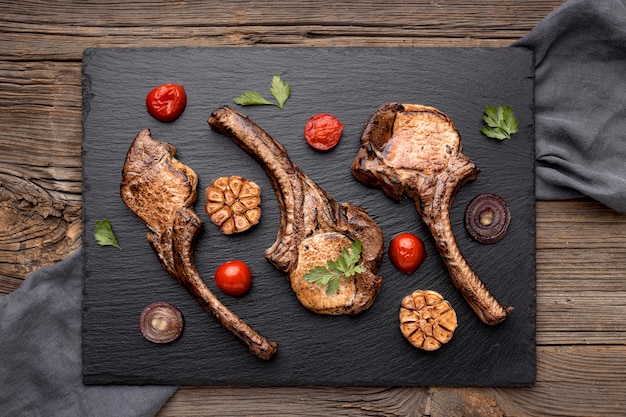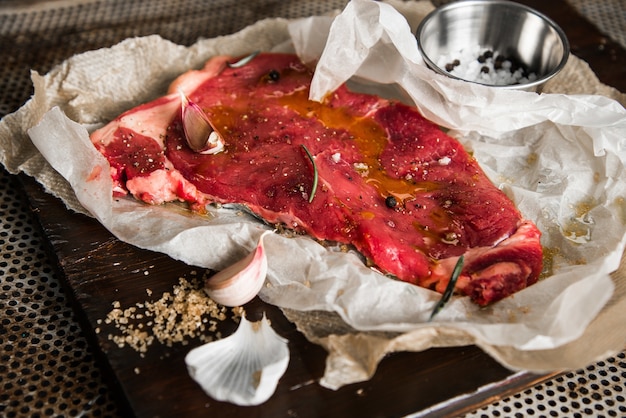(Part 1) Choosing Your Prime Rib: Finding the Perfect Cut

The Bones: More is More
First, let's talk about the bones. A true prime rib should have at least three bones. The more bones, the more flavour. It's all about that rich, bone-in goodness. Personally, I go for a seven-bone roast. It's a statement piece, a showstopper, and perfect for feeding a crowd.The Cut: Two Choices
Now, let's talk about the cut. You have two main choices, and it comes down to personal preference and what you’re looking for: Standing rib roast: This is the classic choice, with the bones intact, standing tall like little soldiers. It’s a bit more traditional and incredibly visually appealing. Rib roast: Here, the bones have been removed, and the meat is tied into a compact roast. It’s a little more practical, easier to cook evenly, and great for carving.I’m a big fan of the standing rib roast – the visual drama is just unbeatable. But in the end, it’s your call.The Marbling: Fat is Flavor
Now, the real deal: the marbling. This is the fat that’s interwoven throughout the meat, and it's what gives prime rib its juicy, tender flavour. You want to see that fat running throughout the meat, not overly dense but present. You want the marbling to be evenly distributed for an outstanding eating experience.The Weight: Feeding the Crowd
Finally, consider the weight. A good rule of thumb is to go for a roast that weighs about 1 pound per person. Remember, you'll always have leftovers, and a prime rib sandwich the next day is a delicious way to extend the feast.(Part 2) Getting Ready: Preparing Your Prime Rib for Success

The Pat-Down: Removing Excess Moisture
First things first, let's pat that roast dry with some paper towels. We want to remove any excess moisture. This will help to achieve a beautiful, crisp, golden crust.The Seasoning: Enhancing Natural Flavors
Now, the moment of truth: the seasoning. This is where you can get creative, but I've found that simple is often best. The goal is to enhance the natural flavour of the beef, not to bury it under a mountain of spices. Salt and pepper: The classic duo. I like to use kosher salt for its coarse texture and freshly ground black pepper for a burst of flavor. Garlic powder: A subtle hint of garlic adds a lovely complexity to the flavour. Paprika: A touch of paprika adds a beautiful color and a hint of smokiness, especially if you use smoked paprika.Season generously, but remember, we want the flavour to sing, not be drowned out by the seasoning.The Resting: Room Temperature Relaxation
This is where the magic happens. We’re going to let our prime rib relax at room temperature for about 30 minutes before cooking. This allows the meat to come to room temperature, which helps it to cook more evenly and consistently.(Part 3) The oven roasting: Classic Technique for Prime Rib Perfection

The Temperature: High and Then Low
I always cook my prime rib at 450°F (232°C) for the first 15 minutes. This high heat helps to sear the outside, creating a beautiful, crispy crust. Then, I reduce the temperature to 325°F (163°C) for the rest of the cooking time.The Timing: Finding the Perfect Doneness
This is where things get a bit more technical. The cooking time depends on the size of your roast and the level of doneness you prefer. Here’s a general guide, but remember, it's always best to use a meat thermometer to be sure: Rare: 12-13 minutes per pound Medium-rare: 14-15 minutes per pound Medium: 16-17 minutes per pound Medium-well: 18-20 minutes per pound Well done: 20-25 minutes per poundThe Basting: Keeping It Moist
Throughout the cooking process, you’ll want to baste the roast with its own juices. This helps to keep the meat moist and prevents it from drying out. You can use a basting brush or spoon, and use a pan underneath the roast to catch the drippings.The Resting: Letting the Juices Redistribute
Once the prime rib is cooked to your desired doneness, don't rush to carve! Let it rest, covered with foil, for at least 15 minutes. This allows the juices to redistribute throughout the meat, resulting in a more tender, succulent roast.(Part 4) The Reverse Sear: A Modern Approach to Prime Rib Cooking
Now for a bit of culinary adventure. The reverse sear is a technique that has gained a lot of fans in recent years. It involves cooking the roast at a low temperature for a longer period, followed by a high-heat sear to create a beautiful, crispy crust.The Low and Slow: Even Cooking
This method involves cooking the prime rib at a low temperature, around 200-225°F (93-107°C), for about 3-4 hours. This slow cooking ensures that the meat cooks evenly and stays incredibly tender.The High-Heat Finish: Crispy Crust and Juicy Center
Once the roast has reached an internal temperature of about 120-125°F (49-52°C), it's time for the final touch: a high-heat sear. This creates a stunning, crispy crust on the outside, while the inside stays juicy and tender.The Timing: Embrace the Longer Cook Time
The cooking time for the reverse sear depends on the size of your roast and the desired doneness. It’s significantly longer than the traditional oven roasting method, but the results are well worth the wait.(Part 5) The Meat Thermometer: Your Prime Rib Ally
Let's be real, you can't just guess when the prime rib is done. It's all about precision. This is where a meat thermometer steps in to be your best friend.The Accuracy: No More Guesswork
A good meat thermometer takes the guesswork out of cooking. It’s the only way to ensure that your prime rib is cooked to perfection, saving you from the dreaded dry, overcooked roast.The Placement: Finding the Perfect Spot
Insert the thermometer into the thickest part of the roast, making sure to avoid the bone. Don’t worry, it won’t damage the roast.The Temperature Guide: Finding Your Perfect Doneness
Here's a temperature guide to help you achieve your desired level of doneness. Remember, these are just guidelines; you might prefer your prime rib cooked to a different temperature. Use the thermometer to ensure your roast is cooked to your liking.| Doneness | Internal Temperature (°F) | Internal Temperature (°C) |
|---|---|---|
| Rare | 125-130 | 52-54 |
| Medium-rare | 130-135 | 54-57 |
| Medium | 140-145 | 60-63 |
| Medium-well | 150-155 | 66-68 |
| Well done | 160 | 71 |
(Part 6) Carving and Serving: Presenting Your prime rib masterpiece
The prime rib is cooked, it's rested, and now it's time for the grand finale: carving and serving. This is the moment of truth!The Carving: Creating Perfect Slices
Use a sharp carving knife to slice the roast into thin, even slices. Start by cutting between the bones, then slice across the grain. This will help to keep the meat tender and ensure that each slice has the perfect texture.The Presentation: A Feast for the Eyes
Now, for the presentation. I like to arrange the carved slices on a platter with a bed of mashed potatoes or roasted vegetables. You can also add some fresh herbs like rosemary or thyme, or a drizzle of gravy for extra flavour.The Accompaniments: Completing the Culinary Experience
Prime rib is a dish that deserves the perfect accompaniments. Here are some classic choices: Roasted vegetables: Brussel sprouts, asparagus, or carrots. The roasting brings out their natural sweetness. Mashed potatoes: Creamy and comforting. They provide a perfect contrast to the rich, savory prime rib. Yorkshire pudding: A classic British side dish that adds a fluffy and flavorful element. Gravy: You can't have prime rib without gravy! It adds moisture and richness. Red wine: The perfect pairing for a rich, flavourful roast. A Cabernet Sauvignon or Merlot would be a great choice.(Part 7) Leftovers: Don’t Waste a Bite
Let's be real, there’s always going to be leftovers. But that’s a good thing!The Sandwich: A Prime Rib Classic
My favourite way to use leftover prime rib? A hearty sandwich. Pile it high on a crusty roll with some horseradish cream and a crisp salad. You'll be craving this one for days.The Soup: Hearty and Flavorful
Another delicious option is to make a hearty prime rib soup. Simply shred the leftover meat and simmer it in a broth with vegetables and spices. It's a great way to warm you up on a chilly day.The Hash: A Rustic and Satisfying Dish
For a more rustic dish, try making prime rib hash. Sauté the leftover meat with potatoes, onions, and peppers for a satisfying and filling meal.(Part 8) Prime Rib: A Culinary Adventure Worth Embracing
I've been cooking prime rib for years, and I can confidently say it's one of my favorite dishes to prepare. It's not just about the delicious food; it's about the experience of bringing people together around a table for a truly special meal.The Journey: Mastering the Art
Cooking prime rib is a culinary adventure. It’s about mastering the art of timing, temperature, and patience. It’s about experimenting with different methods and finding what works best for you.The Rewards: A Memorable Dining Experience
The rewards are worth the effort. The satisfaction of carving a perfectly cooked roast, seeing the smiles on your guests’ faces as they take their first bite, and knowing you’ve created a memorable dining experience.The Fun: Embrace the Challenge
I encourage you to embrace the challenge and have some fun with it. Don’t be afraid to experiment, try new things, and discover what makes your perfect prime rib.FAQs
1. How long should I rest the prime rib after cooking?
Resting the prime rib for at least 15 minutes after cooking is essential to allow the juices to redistribute and ensure a tender and juicy roast.
2. What temperature should I cook the prime rib to for medium-rare?
Aim for an internal temperature of 130-135°F (54-57°C) for medium-rare. Remember, these are just guidelines; you may prefer your prime rib cooked to a different temperature.
3. Can I cook prime rib in a slow cooker?
It’s not recommended to cook prime rib in a slow cooker. The low temperature and long cooking time can make the meat tough and dry. A slow cooker is best for less tender cuts of meat.
4. What kind of wine should I serve with prime rib?
A full-bodied red wine like Cabernet Sauvignon, Merlot, or Zinfandel pairs well with prime rib. The bold flavors of these wines complement the rich and savory taste of the roast.
5. Can I freeze prime rib?
Yes, you can freeze prime rib for up to 3-4 months. Thaw it in the refrigerator for 2-3 days before cooking. Remember, it’s best to freeze prime rib before it’s seasoned, as freezing can affect the texture of the meat.
Everyone is watching

Prime Rib Roast Cooking Time Chart: Per Pound Guide
Cooking TipsPrime rib roast. Just the name conjures images of lavish dinners, crackling fires, and hearty laughter. It’s ...

How Long to Bake Potatoes in the Oven (Perfect Every Time)
Cooking TipsBaked potatoes are a staple in my kitchen. They're incredibly versatile, delicious, and surprisingly easy to m...

Perfect Rice Every Time: The Ultimate Guide to Cooking Rice
Cooking TipsAs a self-proclaimed foodie, I've always been a bit obsessed with rice. It's the foundation of countless cuisi...

The Ultimate Guide to Cooking Asparagus: Tips, Techniques, and Recipes
Cooking TipsAsparagus. The mere mention of this spring delicacy conjures up images of vibrant green spears, crisp and burs...

Ultimate Guide to Cooking the Perfect Thanksgiving Turkey
Cooking TipsThanksgiving. Just the word conjures up images of overflowing tables laden with delicious food, the scent of r...
